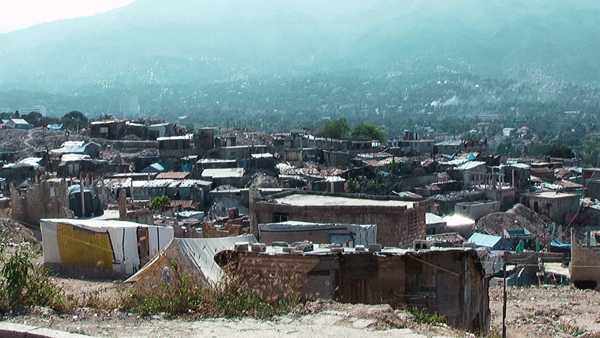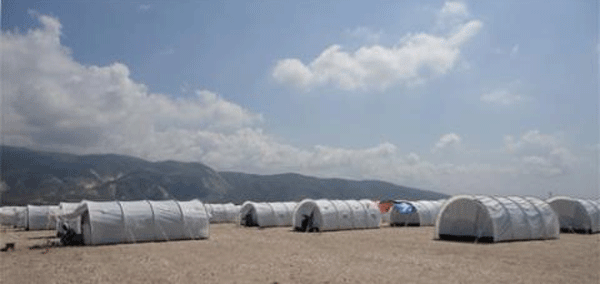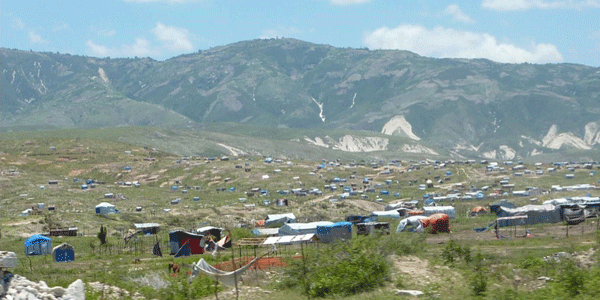Fort National, stuck between rubble... and doubts
An article from AlterPresse, one of the Haiti Grassroots Watch partners, written with the participation of Haiti Grassroots Watch
Port-au-Prince, Jan. 12 2011 – “The continual invasions of thieves and rain… We couldn’t take it any more, so we came back,” said Annette, explaining why she left the Champs de Mars camp and returned to her old neighborhood, Fort National, not far from the National Palace.
Today Annette lives on a tiny piece of land not much bigger than a handkerchief, in a handmade, patchwork shack attached of one of her friend’s equally ramshackle hut.
One year later, the “popular neighborhoods” – meaning the most impoverished neighborhoods – are fields of ruins rather than fields of dreams. In the Fort National area, where the government has promised to build a vast public housing project, a certain number of former residents who were down near the Palace have “come home.”
With pieces of scrap sheet metal, sheets and tarps, they’ve built huts on top of the rubble of destroyed houses, hoping to benefit from the government’s promises. But the distance between that hope, and an actual home, is great and the challenges many. And it appears that the poor neighborhoods – like Fort National – aren’t the priority.

Fort National - the reality. Photo: Accesomedias
“There’s been a lot of effort when it concerns the formal part of the city, but not for the ‘informal’ neighborhoods. But where are the refugees from? They’re from those ‘informal’ neighborhoods. Removing the rubble from those neighborhoods is much more complicated than removing it from formal neighborhoods.
"There is no access, the terrain is difficult, so you need different approaches. And we are only really starting to work on that now,” Jean-Christophe Adrian, director of UN-HABITAT in Haiti, told AlterPresse and Haiti Grassroots Watch. UN-HABITAT is also director of the “Shelter Cluster” that groups together the 200 agencies and “non-governmental organizations” working on the housing issue.
On January 12, the government plans to announce its project of 3,000 to 4,000 apartments in Fort National. [FLASH - Protests blocked the inauguration on Jan. 12. See AlterPresse article in French.]
“It is a project of public housing high-rises, respecting building norms for earthquake zones, which will house many hundreds of families,” Jacques Gabriel, Minister of Public Works, told Agence France Presse.

Fort National - the dream. Leaflet handed out by government representatives
at Fort National on Janury 12. Text says "Haitians, let's take control of our
country's destiny."
But, according to an Interim Haiti Recovery Commission authority, the Fort National project is not 100 percent certain.
“There are still a lot of questions that have to be worked out,” according to Priscilla Phelps, Senior Advisor on Housing and Neighborhoods for the IHRC.
“The proposal they have made is one that needs some vetting. It’s quite expensive,” she added.
Phelps is not the only one with questions or doubts. The residents of the neighborhood – which was devastated by the earthquake – don’t even try to hide their skepticism.
“You can see the reality we are living, right? What else is there to add? We keep hearing them talk about reconstruction but nothing has been done,” said one of Annette’s indignant neighbors.
Shelter Cluster authorities are also skeptical.
“Our experience shows us that, in all countries, these types of projects end up benefiting the middle classes. They don’t benefit the poorest people who were renters before the earthquake,” Adrian said.
The government has already had its share of disastrous projects, like the Corail Cesselesse “transitional camp.”

The camp

The area near the camp
Following the announcement that the 7,000 hectares of land in the area were “in the public interest,” between 60,000 and 120,000 people moved onto the plains and slope surrounding the camp, which houses about 7,000 people.
“With Corail, the government opened a Pandora’s Box, and the land was invaded,” Adrian reminded. He also added that these kinds of camps, that expand the urban area, are not “recommended.”
“Today we realize that it was not such a good idea, because in fact, we participated in the creation of the next big slum for Port-au-Prince.”
Listen to an interview (in French) with Adrian on Corail and see "before and after images"
Read also What is the (re-)housing plan?
Return to the introduction page for January 12 Dossier with texts and video

